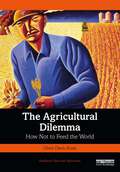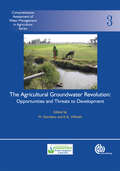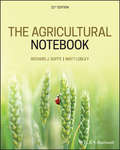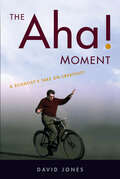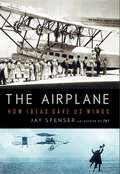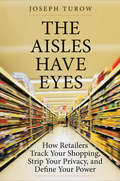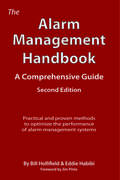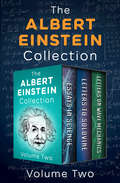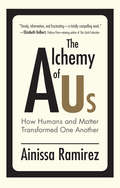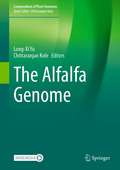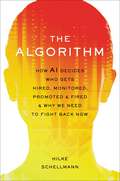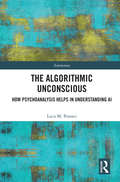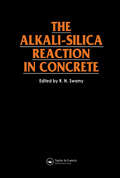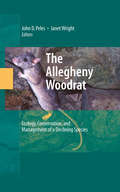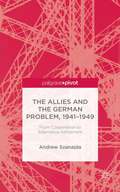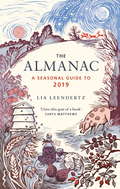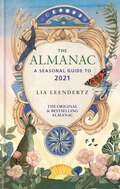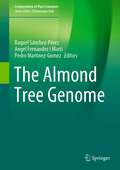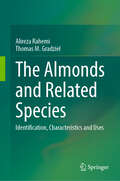- Table View
- List View
The Agricultural Dilemma: How Not to Feed the World (Earthscan Food and Agriculture)
by Glenn Davis StoneThe Agricultural Dilemma questions everything we think we know about the current state of agriculture and how to, or perhaps more importantly how not to, feed a world with a growing population. This book is about the three fundamental forms of agriculture: Malthusian (expansion), industrialization (external-input-dependent), and intensification (labor-based). The best way to understand the three agricultures, and how we tend to get it wrong, is to consider what drives their growth. The book provides a thoughtful, critical analysis that upends entrenched misconceptions such as that we are running out of land for food production and that our only hope is the development of new agricultural technologies. The book contains engaging and enlightening vignettes and short histories, with case studies drawn from across the globe to bring to life this important debate and dilemma. The book concludes by arguing there is a viable alternative to industrial agriculture which will allow us to meet the world's needs and it ponders why such alternatives have been downplayed, obscured, or hidden from view. This important book is essential reading for all studying and researching food production and agriculture, and more broadly for all interested in ensuring we are able to feed our growing population.
The Agricultural Groundwater Revolution: Opportunities and Threats to Development
by Mark Giordano Karen G. VillholthWhile addressing the issues of using groundwater in agriculture for irrigation in the developing world, this book discusses the problems associated with the degradation and over-exploitation of using it. It explores the practiced and potential methods for its management in the context of agricultural development.
The Agricultural Notebook
by Matt Lobley Richard J. SoffeOffers a complete update and revision to the manual for agriculture, geography, and rural studies The 21st edition of the quintessential reference book on agriculture is filled with updated and new material that provides those in the farming profession with everything they need to know about today’s agricultural industry. Filled with contributions from top experts in the field, it provides not only the scientific explanations behind agriculture, but also a range of further reading . The Agricultural Notebook, 21st Edition features new chapters that address wildlife, the fundamentals of agricultural production, and the modern techniques critical to the industry. It offers new chapters on sheep, goats, ruminant nutrition, monogastric nutrition, and resource management. It also takes a more in-depth approach to plant nutrition, and greater attention to environmental elements. Other topics covered include: soil management & crop nutrition; animal welfare; crop physiology; farm woodland management; farm machinery; and more. • Reflects recent changes in the world of agriculture, farming, and the rural environment • Features a new chapter on Resource Management • Offers separate chapters on goats, sheep, and applied nutrition • Every chapter is revised by experts in their subject area The Agricultural Notebook is an essential purchase for all students of agriculture, countryside, and rural studies. It will also greatly benefit farmers, land agents, agricultural scientists, advisers, and suppliers to the agriculture industry.
The Aha! Moment: A Scientist's Take on Creativity
by David JonesThis book is about having ideas and—a much longer haul—making them work. David Jones, best known for his Daedalus column, tells a multitude of stories about creators and their creations, including his own fantastical-seeming contributions to mainstream science such as the unrideable bicycle and chemical gardens in space. His theory of creativity endows each of us with a Random-Ideas Generator, a Censor, and an Observer-Reasoner. Jones applies his theory to a wide range of weird scientific experiments that he has conducted for serious scientific papers, for challenging printed expositions, and for presentations to a TV audience. He even suggests new ones, not yet tried! Creativity is as essential to science as curiosity, physical intuition, and shrewd deduction from well-planned experiments. But, says Jones, ingenuity is very uncertain. Even for the greatest inventors, about 80 percent of ideas fail. Jokiness can help, and so can lots of random data. Jones has plenty of clever advice that will help spark that madly brilliant private thought in the first place—and will encourage you to take it further.Neither dense nor demanding, The Aha! Moment is engrossing, edifying, and scientifically serious; yet it is lightly written and asks lots of silly questions. As Jones shows, it can often pay to take an absurd idea seriously.
The Airplane Alphabet Book (Jerry Pallotta's Alphabet Books)
by Jerry Pallotta Fred StillwellLet your imagination take flight! This fact-filled book features planes from A to Z, including the Aviation Trainer Six, the Electra, and the Zero. An high-flying tour of the alphabet and a history of flying machines the Wright Brothers to hobbyist's model airplanes. Learn which type of plane is best for a dogfight, see the type of plane Charles Lindbergh flew in the first nonstop flight across the Atlantic, and much more. From the first flight of the Wright Flyer in 1903 to the age of jets, Rob Bolster's vivid illustrations will send you soaring through the skies in this dynamic celebration of flight.
The Airplane: How Ideas Gave Us Wings
by Jay SpenserIn this entertaining history of the jetliner, Jay Spenser traces aviation's challenges from the outset, and follows the flow of the simple yet powerful ideas that led us to defy gravity. Here are the pioneers—innovators such as Otto Lilienthal, Igor Sikorsky, Louis Blériot, Hugo Junkers, and Jack Northrop—whose amazing contributions collectively solved the puzzle of flight. Along the way, Spenser demystifies the modern jetliner, examining the airplane from wings to flight controls to fuselages to landing gear, to show how each part came into being and evolved over time. And finally The Airplane addresses the future of aviation, outlining the breathtaking possibilities that await us tomorrow, many miles above the earth.Who were aviation's dreamers, and where did they get their inspiration?How did birds, insects, marine mammals, and fish help us to fly?How did the bicycle beget the airplane, and hot water heaters lead to metal fuselages?Who figured out how to fly without seeing the ground, enabling airline travel in all weather conditions?
The Aisles Have Eyes: How Retailers Track Your Shopping, Strip Your Privacy, and Define Your Power
by Joseph TurowThe author of Media Today offers &“a trenchant, timely, and troubling account of [retailers&’] data-mining, in-store tracking, and predictive analytics&” (The Philadelphia Inquirer). By one expert&’s prediction, within twenty years half of Americans will have body implants that tell retailers how they feel about specific products as they browse their local stores. The notion may be outlandish, but it reflects executives&’ drive to understand shoppers in the aisles with the same obsessive detail that they track us online. In fact, a hidden surveillance revolution is already taking place inside brick-and-mortar stores, where Americans still do most of their buying. Drawing on his interviews with retail executives, analysis of trade publications, and experiences at insider industry meetings, advertising and digital studies expert Joseph Turow pulls back the curtain on these trends, showing how a new hyper-competitive generation of merchants—including Macy&’s, Target, and Walmart—is already using data mining, in-store tracking, and predictive analytics to change the way we buy, undermine our privacy, and define our reputations. Eye-opening and timely, Turow&’s book is essential reading to understand the future of shopping. &“Turow shows shopping today to be an exercise in unwitting self-revelation—and not only online.&”—The Wall Street Journal &“Thoroughly researched and clearly presented with detailed evidence and fascinating peeks inside the retail industry. Much of this information is startling and even chilling, particularly when Turow shows how retail data-tracking can enable discrimination and societal stratification.&”—Publishers Weekly &“Revealing . . . Valuable reading for shoppers and retailers alike.&”—Kirkus Reviews
The Alarm Management Handbook - Second Edition: A Comprehensive Guide
by Jim Pinto Bill Hollifield Eddie HabibiThe Second Edition of the most complete best practices book available for designing and maintaining an effective alarm management system. Investigation reports on industrial accidents often point to faulty alarm systems as a contributing factor. Properly designed and maintained alarm systems significantly improve plant safety, reliability, and profitability. The Alarm Management Handbook provides a field-proven methodology for improving the performance of industrial facility's alarm systems. It derives from over a decade of research and the lessons learned from hundreds of successful alarm improvement projects. The implications of the new ANSI/ISA-18.2-2009 Management of Alarm Systems for the Process Industries are also detailed in the book. Companies have achieved breakthrough results by following the principles contained in this book. Whatever the nature of your alarm system, The Alarm Management Handbook is a necessary part of your operational excellence and other business improvement initiatives. This book will help you make a long-lasting mark in your organization by providing you with strategies to improve your company's bottom line.
The Albert Einstein Collection Volume Two: Essays in Science, Letters to Solovine, and Letters on Wave Mechanics
by Albert EinsteinFrom revealing, personal letters to brilliant essays on the nature of science, these three volumes demonstrate the breadth of Einstein&’s thought. The man who became famous for conceiving of the equation E=mc2 kept his mind sharp through stimulating correspondence and applied his intellectual acuity to a number of important scientific issues. The second volume of the Albert Einstein Collection offers a fascinating window into how he developed his ideas. Essays in Science: In these sixteen essays, written at the height of his intellectual powers, Einstein sets out his views on scientific knowledge, its relationship to human experience, and the underlying principles of any scientific pursuit. He discusses his own work in theoretical physics and its basis in field theory, as well as the many achievements of other scientific thinkers—including Johannes Kepler, Isaac Newton, James Clerk Maxwell, Max Planck, Niels Bohr, and others. Letters to Solovine: This collection of personal letters from Einstein to his longtime friend and translator Maurice Solovine offers a rare glimpse into the evolution of his thought, as well as a revealing portrait of the man himself. Spanning Einstein&’s career and ranging from philosophical discussion to personal gossip, these letters are presented in English translation alongside the German text, with facsimiles of the original letters also included. Letters on Wave Mechanics: In this stirring collection of correspondence, four of the twentieth century&’s greatest minds—H. A. Lorentz, Max Planck, Erwin Schrödinger, and Albert Einstein—discuss, debate, and refine Schrödinger&’s then-nascent theory of wave mechanics. As the physicist Karl Przibram states in his foreword to this edition, &“little needs to be added to the letters; they speak for themselves. Apart from their essential content, they reveal something of the personalities of the four men of genius.&”
The Alchemy of Us: How Humans and Matter Transformed One Another (The\mit Press Ser.)
by Ainissa RamirezIn the bestselling tradition of Stuff Matters and The Disappearing Spoon: a clever and engaging look at materials, the innovations they made possible, and how these technologies changed us. In The Alchemy of Us, scientist and science writer Ainissa Ramirez examines eight inventions—clocks, steel rails, copper communication cables, photographic film, light bulbs, hard disks, scientific labware, and silicon chips—and reveals how they shaped the human experience. Ramirez tells the stories of the woman who sold time, the inventor who inspired Edison, and the hotheaded undertaker whose invention pointed the way to the computer. She describes, among other things, how our pursuit of precision in timepieces changed how we sleep; how the railroad helped commercialize Christmas; how the necessary brevity of the telegram influenced Hemingway's writing style; and how a young chemist exposed the use of Polaroid's cameras to create passbooks to track black citizens in apartheid South Africa. These fascinating and inspiring stories offer new perspectives on our relationships with technologies. Ramirez shows not only how materials were shaped by inventors but also how those materials shaped culture, chronicling each invention and its consequences—intended and unintended. Filling in the gaps left by other books about technology, Ramirez showcases little-known inventors—particularly people of color and women—who had a significant impact but whose accomplishments have been hidden by mythmaking, bias, and convention. Doing so, she shows us the power of telling inclusive stories about technology. She also shows that innovation is universal—whether it's splicing beats with two turntables and a microphone or splicing genes with two test tubes and CRISPR.
The Alfalfa Genome (Compendium of Plant Genomes)
by Chittaranjan Kole Long-Xi YuThis book is the first comprehensive compilation of deliberations on whole genome sequencing of the diploid and tetraploid alfalfa genomes including sequence assembly, gene annotation, and comparative genomics with the model legume genome, functional genomics, and genomics of important agronomic characters. Other chapters describe the genetic diversity and germplasm collections of alfalfa, as well as development of genetic markers and genome-wide association and genomic selection for economical important traits, genome editing, genomics, and breeding targets to address current and future needs. Altogether, the book contains about 300 pages over 16 chapters authored by globally reputed experts on the relevant field in this crop. This book is useful to the students, teachers, and scientists in the academia and relevant private companies interested in genetics, breeding, pathology, physiology, molecular genetics and breeding, biotechnology, and structural and functional genomics. The work is also useful to seed and forage industries.
The Algorithm: How AI Decides Who Gets Hired, Monitored, Promoted, and Fired and Why We Need to Fight Back Now
by Hilke SchellmannBased on exclusive information from whistleblowers, internal documents, and real world test results, Emmy‑award winning Wall Street Journal contributor Hilke Schellmann delivers a shocking and illuminating expose on the next civil rights issue of our time: how AI has already taken over the workplace and shapes our future. Hilke Schellmann, is an Emmy‑award winning investigative reporter, Wall Street Journal and Guardian contributor and Journalism Professor at NYU. In The Algorithm, she investigates the rise of artificial intelligence (AI) in the world of work. AI is now being used to decide who has access to an education, who gets hired, who gets fired, and who receives a promotion. Drawing on exclusive information from whistleblowers, internal documents and real‑world tests, Schellmann discovers that many of the algorithms making high‑stakes decisions are biased, racist, and do more harm than good. Algorithms are on the brink of dominating our lives and threaten our human future—if we don't fight back. Schellmann takes readers on a journalistic detective story testing algorithms that have secretly analyzed job candidates' facial expressions and tone of voice. She investigates algorithms that scan our online activity including Twitter and LinkedIn to construct personality profiles à la Cambridge Analytica. Her reporting reveals how employers track the location of their employees, the keystrokes they make, access everything on their screens and, during meetings, analyze group discussions to diagnose problems in a team. Even universities are now using predictive analytics for admission offers and financial aid.
The Algorithmic Unconscious: How Psychoanalysis Helps in Understanding AI (Antinomies)
by Luca M. PossatiThis book applies the concepts and methods of psychoanalysis to the study of artificial intelligence (AI) and human–AI interaction. It develops a new, more fruitful approach for applying psychoanalysis to AI and machine behavior. It appeals to a broad range of scholars: philosophers working on psychoanalysis, technology, AI ethics, and cognitive sciences, psychoanalysts, psychologists, and computer scientists. The book is divided into four parts. The first part (Chapter 1) analyzes the concept of "machine behavior." The second part (Chapter 2) develops a reinterpretation of some fundamental Freudian and Lacanian concepts through Bruno Latour’s actor-network theory. The third part (Chapters 3 and 4) focuses on the nature and structure of the algorithmic unconscious. The author claims that the unconscious roots of AI lie in a form of projective identification, i.e., an emotional and imaginative exchange between humans and machines. In the fourth part of the book (Chapter 5), the author advances the thesis that neuropsychoanalysis and the affective neurosciences can provide a new paradigm for research on artificial general intelligence. The Algorithmic Unconscious explores a completely new approach to AI, which can also be defined as a form of "therapy." Analyzing the projective identification processes that take place in groups of professional programmers and designers, as well as the "hidden" features of AI (errors, noise information, biases, etc.), represents an important tool to enable a healthy and positive relationship between humans and AI. Psychoanalysis is used as a critical space for reflection, innovation, and progress.
The Alien Probe (Tom Swift III, Book #3)
by Victor AppletonFrom the back of the book: When a mysterious and top-secret alien probe, which Tom found on Jupiter, is stolen from Swift Enterprises, Tom Swift rockets into another exciting mission. The information locked in the probe is invaluable, and Tom must find it at all costs. He and his friends, Anita and Ben, chase the thief through underground caverns and, using their high-powered space-ships, through the blackness of space--risking everything they have to find the alien probe and reveal its secrets.
The Alkali-Silica Reaction in Concrete
by R. N. SwamyThis book reviews the fundamental causes and spectrum effects of ASR. It considers he advances that have been made in our understanding of this problem throughout the world.
The All-Together Quilt
by Lizzy RockwellQuilters and crafters rejoice! This story of a community coming together to make a quilt is a heartwarming celebration of creativity and teamwork.The kids and grown-ups at a community center begin with lots of colorful fabrics and an idea. Then step by step they make that idea a reality. They design, cut, stitch, layer, and quilt. It's the work of many hands, many hours, and many stories. And the result is something warm and wonderful they all can share.Lizzy Rockwell is the artistic director and organizing force behind the Norwalk Community Quilt Project: Peace by Piece, and this book is inspired by all the people who have gathered over the years to teach and learn and to make something beautiful together.
The Allegheny Woodrat
by John Peles Janet WrightA decline in populations of Allegheny woodrats (Neotoma magister) was first noticed in the 1980s. Since that time, woodrats have become extirpated from at least two states and have declined dramatically in several others. Recent evidence suggests that the decline of this species may be proceeding further south to include states where woodrat populations were previously considered to be stable. The Allegheny Woodrat: Ecology, Conservation, and Management of a Declining Species provides a comprehensive summary of research conducted over the past twenty-five years. The book integrates the results of this research into a comprehensive picture of the ecological requirements, conservation principles, and management strategies for this declining species. In addition, general principles learned from the study of woodrats are applied to the conservation and management of other declining species, including other species of Neotoma. The editors and chapter authors are researchers from both academic settings and state management agencies, individuals who have contributed significantly to the study of Allegheny woodrats during the past two decades. The book will be of interest to ecologists, conservation biologists, wildlife professionals, and students.
The Alliance: A Registry Novel (Registry Novels #3)
by Shannon StokerA rebel goes undercover in a desperate attempt to free her country from a brutal dictator in the final novel of this dystopian thriller trilogy.In America, the Registry weds girls to the highest bidder and raises boys for its army. Mia Morrissey fled to Mexico to claim her freedom. Now, she’s going risk everything so that the rest of America can be free.Going undercover as part of a diplomatic mission, Mia returns to an America even more dangerous than the one she left. The forgotten country faces its most ruthless leader yet, Grant Marsden—a shadow from Mia’s past. With the help of the subversive group Affinity, she embarks on a perilous journey to defeat Grant, bring down the government, and destroy the Registry once and for all.But when a terrible betrayal exposes the operation, Mia discovers that her enemies have used her—and so have her friends. Alone and frightened, Mia knows that her next step may be the last for her . . . and America.
The Allies and the German Problem, 1941–1949: From Cooperation to Alternative Settlement
by Andrew SzanajdaThe Allies and the German Problem, 1941-1949 examines Allied policymaking during the Second World War and the military occupation of postwar Germany, demonstrating how the initial unity of the Allies disintegrated during the postwar military occupation in the face of their separate goals for postwar Germany and Europe.
The Almanac: A Seasonal Guide to 2019
by Lia LeendertzTHE ORIGINAL & BESTSELLING ALMANAC 'I love this gem of a book' - Cerys Matthews 'This book is your bible' - The Independent '...it already feels like an annual necessity' - India Knight'Joyous' - Allan Jenkins'Updated for 2019 with more lovely ideas to celebrate the seasons' - Gardens Illustrated'A charming book. This is a real gem of a gift' - Sunday Express, S Magazine. A perfect toolkit connecting with the world around us and the year ahead as it unfolds - all in a compact and pocket size that just begs you to pick it up and browse - Reckless Gardener or Its range of information and depth of understanding of our seasons is priceless - Reckless GardenerThe Almanac: A Seasonal Guide to 2019 reinvents the tradition of the rural almanac for a new audience. It gives you the tools and inspiration you need to celebrate, mark and appreciate each month of the year in your own particular way. Divided into the 12 months, a set of tables each month gives it the feel and weight of a traditional almanac, providing practical information that gives access to the outdoors and the seasons, perfect for expeditions, meteor-spotting nights and beach holidays. There are also features on each month's unique nature, such as the meteor shower of the month, beehive behaviour, folklore and stories, seasonal recipes and charts tracking moon phases and tides. Why not try identifying trees by their bare buds in January; Enjoy Buttermilk scones with orangle blossom & honey butter in June; Discover the Chinese New Year story of 'The great race' in February.You will find yourself referring to the almanac all year long, revisiting it again and again, and looking forward to the next edition as the year draws to a close.Praise for The Almanac: A Seasonal Guide to 2018:'The perfect companion to the seasons' - India Knight'A richly layered book of events, celebrations and everyday information that together create a beautiful, fascinating resource . . . In the single month I've had my hands on it, the book has quietly "worked".' - Telegraph'Beautifully written, this pocket-sized guide is a labour of love and will remind you to appreciate little moments throughout the year.' - Gardens Illustrated'Elegant . . . an ideal stocking filler.' - The English Garden
The Almanac: A Seasonal Guide to 2019
by Lia LeendertzTHE ORIGINAL & BESTSELLING ALMANAC 'I love this gem of a book' - Cerys Matthews 'This book is your bible' - The Independent '...it already feels like an annual necessity' - India Knight'Joyous' - Allan Jenkins'Updated for 2019 with more lovely ideas to celebrate the seasons' - Gardens Illustrated'A charming book. This is a real gem of a gift' - Sunday Express, S Magazine. A perfect toolkit connecting with the world around us and the year ahead as it unfolds - all in a compact and pocket size that just begs you to pick it up and browse - Reckless Gardener or Its range of information and depth of understanding of our seasons is priceless - Reckless GardenerThe Almanac: A Seasonal Guide to 2019 reinvents the tradition of the rural almanac for a new audience. It gives you the tools and inspiration you need to celebrate, mark and appreciate each month of the year in your own particular way. Divided into the 12 months, a set of tables each month gives it the feel and weight of a traditional almanac, providing practical information that gives access to the outdoors and the seasons, perfect for expeditions, meteor-spotting nights and beach holidays. There are also features on each month's unique nature, such as the meteor shower of the month, beehive behaviour, folklore and stories, seasonal recipes and charts tracking moon phases and tides. Why not try identifying trees by their bare buds in January; Enjoy Buttermilk scones with orangle blossom & honey butter in June; Discover the Chinese New Year story of 'The great race' in February.You will find yourself referring to the almanac all year long, revisiting it again and again, and looking forward to the next edition as the year draws to a close.Praise for The Almanac: A Seasonal Guide to 2018:'The perfect companion to the seasons' - India Knight'A richly layered book of events, celebrations and everyday information that together create a beautiful, fascinating resource . . . In the single month I've had my hands on it, the book has quietly "worked".' - Telegraph'Beautifully written, this pocket-sized guide is a labour of love and will remind you to appreciate little moments throughout the year.' - Gardens Illustrated'Elegant . . . an ideal stocking filler.' - The English Garden
The Almanac: A Seasonal Guide to 2021
by Lia Leendertz'The perfect companion to the seasons' - India KnightWelcome to The Almanac: A Seasonal Guide to 2021. If you are new to The Almanac then welcome; if you are a regular reader then hello! The Almanac is about celebrating the unfolding year in all its various facets. The old dependables which I include every year are back: moon phases, sun rises and sets, tide time tables and the sky at night. As ever there are seasonal recipes and monthly gardening tips for the flower and vegetable garden too, as well as a bit of folklore, and nature and a song for each month.This year's edition has a theme: movement, migration and pilgrimage. This was not a reaction to the unsettling events of last year - it was half written by the time Covid-19 hit - but writing it from lockdown did give me a heightened appreciation of the way in which Britain and Ireland have always and continue to be places of movement, and are intimately connected to the rest of the world. You will find within this book migration tales for each month of this year, but I have also searched out seasonal tales of human movement, and included a pilgrimage for each month, some ancient, some current, all underlining the spiritual benefits of putting one foot in front of the other. Every month I have included a method of navigating using the stars, sun or moon, so you can find your way around in the dark (or just look out of your window and know where south is). And our monthly folk songs are all shanties this year, work songs with movement at their very heart, created to coordinate muscle power to drive sailing ships backwards and forwards across the Atlantic Ocean, and containing influences from the eastern seaboard of the US down to the Caribbean and beyond mixed with British and Irish folk traditions. These songs are stitched through with movement and travel, as is this Almanac.PRAISE FOR THE ALMANAC: A SEASONAL GUIDE'This book is your bible' - The Independent'An ideal stocking filler' - The English Garden'I love this gem of a book' - Cerys Matthews'Indispensable' - Sir Bob Geldof'An uplifting nature-inspired guide' - Country & Town House magazine
The Almanac: A Seasonal Guide to 2021
by Lia Leendertz'The perfect companion to the seasons' - India KnightWelcome to The Almanac: A Seasonal Guide to 2021. If you are new to The Almanac then welcome; if you are a regular reader then hello! The Almanac is about celebrating the unfolding year in all its various facets. The old dependables which I include every year are back: moon phases, sun rises and sets, tide time tables and the sky at night. As ever there are seasonal recipes and monthly gardening tips for the flower and vegetable garden too, as well as a bit of folklore, and nature and a song for each month.This year's edition has a theme: movement, migration and pilgrimage. This was not a reaction to the unsettling events of last year - it was half written by the time Covid-19 hit - but writing it from lockdown did give me a heightened appreciation of the way in which Britain and Ireland have always and continue to be places of movement, and are intimately connected to the rest of the world. You will find within this book migration tales for each month of this year, but I have also searched out seasonal tales of human movement, and included a pilgrimage for each month, some ancient, some current, all underlining the spiritual benefits of putting one foot in front of the other. Every month I have included a method of navigating using the stars, sun or moon, so you can find your way around in the dark (or just look out of your window and know where south is). And our monthly folk songs are all shanties this year, work songs with movement at their very heart, created to coordinate muscle power to drive sailing ships backwards and forwards across the Atlantic Ocean, and containing influences from the eastern seaboard of the US down to the Caribbean and beyond mixed with British and Irish folk traditions. These songs are stitched through with movement and travel, as is this Almanac.PRAISE FOR THE ALMANAC: A SEASONAL GUIDE'This book is your bible' - TheIndependent'An ideal stocking filler' - The English Garden'I love this gem of a book' - Cerys Matthews'Indispensable' - Sir Bob Geldof'An uplifting nature-inspired guide' -Country & Town House magazine
The Almond Tree Genome (Compendium of Plant Genomes)
by Pedro Martínez-Gómez Raquel Sánchez-Pérez Ángel Fernández i MartíThis book brings together the latest information on almond genomics and transcriptomics, with a particular focus on cutting-edge findings, tools, and strategies employed in genome sequencing and analysis with regard to the most important agronomic traits. Cultivated almond [(Prunus dulcis (Miller) D. A. Webb, syn. Prunus amygdalus Batsch., Amygdalus communis L., Amygdalus dulcis Mill.)] is a tree crop producing seeds of great economic interest, and adapted to hot and dry climates. Domesticated in Southeast Asia, its small diploid genome and phenotypic diversity make it an ideal model to complement genomics studies on peach, generally considered to be the reference Prunus species. Both represent consanguineous species that evolved in two distinct environments: warmer and more humid in the case of peach, and colder and xerophytic for almond. The advent of affordable whole-genome sequencing, in combination with existing Prunus functional genomics data, has now made it possible to leverage the novel diversity found in almond, providing an unmatched resource for the genetic improvement of this species.
The Almonds and Related Species: Identification, Characteristics and Uses
by Thomas M. Gradziel Alireza RahemiAlmond and peach species have global importance as food crops as well as use in landscaping including restoration and reforestation. Because currently available breeding germplasm has a very narrow genetic base, genetic improvement programs are turning to wild germplasm as sources of improved quality, productivity and resistance traits. This germplasm is also enabling the dramatic modification of traditional cropping systems as with the transfer of self-fruitfulness from related wild almond and peach species to normally self-sterile cultivated almond. While presence of an extensive wild almond and related germplasm has been documented in the literature over the past century, most information remains dispersed and often not generally accessible owing to its publication in treatises and journals of limited distribution. This monograph brings together a comprehensive characterization of almond and its related species including the cultivated and wild peaches. Because it represents the only comprehensive source of information on almond, peach and their wild relatives, it represents a basic reference text of interest to researchers in both the basic and applied plant and ecological sciences.
